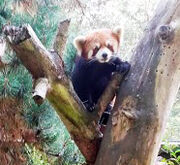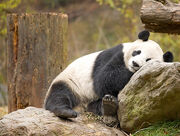(Added fun photo for convergent evolution.) |
No edit summary |
||
| Line 4: | Line 4: | ||
==Antifreeze fish== |
==Antifreeze fish== |
||
Fish living in the coldest waters of the world, north and south, have developed proteins that allow them to survive in these cold waters without their bodies freezing. Scientists have even discovered that the proteins of the fish in the north and south occur in different genetic sequences showing they both develped independently. |
Fish living in the coldest waters of the world, north and south, have developed proteins that allow them to survive in these cold waters without their bodies freezing. Scientists have even discovered that the proteins of the fish in the north and south occur in different genetic sequences showing they both develped independently. |
||
| + | ==Giant and red pandas== |
||
| + | [[File:Panda_tree.jpg|thumb|Red pandas are arboreal specialized carnivores.]] |
||
| + | |||
| + | Giant and red pandas inhabit the same range and possess some of the same features, although they are not actually closely related (Gittleman, 1994). Giant pandas are Ursidae, or bears, whereas red pandas are unique enough to be in their own family Ailuridae (Flynn, et al., 2000). Both species live in the bamboo forests of the Himalayas and subsist primarily on the bamboo that grows there (Fisher, et al., 2009). Several features are simliar in both species, and clearly coevolved in response to their environment. Both species are ancient carnivores that developed a taste for bamboo, and thereby evolved to depend upon it rather than meat. Specifically, both giant pandas and red pandas have |
||
| + | [[File:CHINA).jpg|thumb|Giant pandas are terrestrial specialized carnivores.]]carnivorous digestive systems, but have well developed skulls and jaws for masticating tough bamboo stalks and leaves (Figueirido, Serrano-Alarcon, & Palmqvist, 2012). They also both have elongated wrist bones that serve as a "false-thumb" on their front paws (Figueirido, Serrano-Alarcon, & Palmqvist, 2012). The difference between the giant panda's "false-thumb" and the red panda's "false-thumb" are how they are utilized. Giant pandas use their "false-thumb" for manipulation of bamboo (Figueirido, Serrano-Alarcon, & Palmqvist, 2012) whereas red pandas evolved their "false-thumb" as a response to the need to become an arboreal species (Anton et al., 2006). Additionally, giant pandas and red pandas also have early, undeveloped young which require several months of dedicated care. (AZA, n.d.). |
||
| + | |||
==References== |
==References== |
||
| + | <p class="MsoNormal" style="margin-left:.5in;text-indent:-.5in;line-height:150%"></p> |
||
| + | |||
| + | <p class="MsoNormal" style="margin-left:0.5in;text-indent:-0.5in;line-height:150%;"><span style="font-size:12.0pt;line-height:150%">Anton, M., Salesea, M.J., Pastor, J.F., Peigne, S., & Morales, J. (2006). Implications of the'' ''functional anatomy of the hand and forearm of ''Ailurus fulgens'' (Carnivora, Ailuridae) for the evolution of the ‘false-thumb’ in pandas. ''J. Anat.'', 209, 757-764. doi: 10.1111/j.1469-7580.2006.00649.x |
||
| + | </span></p> |
||
| + | |||
| + | <p class="MsoNormal" style="margin-left:0.5in;text-indent:-0.5in;line-height:150%;"></p> |
||
| + | |||
| + | <p class="MsoNormal" style="margin-left:0.5in;text-indent:-0.5in;line-height:150%;"><span style="font-size:12.0pt;line-height:150%">AZA Small Carnivore TAG. (2012). Red panda care manual.</span></p> |
||
| + | |||
| + | <p class="MsoNormal" style="margin-left:0.5in;text-indent:-0.5in;line-height:150%;"><span style="font-size:12.0pt;line-height:150%"> |
||
| + | </span></p> |
||
| + | |||
| + | |||
| + | |||
| + | <p class="MsoNormal" style="margin-left:0.5in;text-indent:-0.5in;line-height:150%;"><span style="font-size:12.0pt;line-height:150%">Figueirido, B., Serrano-Alarcon, F.J., & Palmqvist, P. (2012). Geometric morphometrics shows differences and similarities in skull shape between the red and giant pandas. ''Journal of Zoology'', 286, 293-302. doi: 10.1111/j.1469-7998.2011.00879.x</span></p> |
||
| + | |||
| + | <p class="MsoNormal" style="margin-left:0.5in;text-indent:-0.5in;line-height:150%;"><span style="font-size:12.0pt;line-height:150%"> |
||
| + | </span></p> |
||
| + | |||
| + | |||
| + | |||
| + | <p class="MsoNormal" style="margin-left:0.5in;text-indent:-0.5in;line-height:150%;"></p> |
||
| + | |||
| + | <p class="MsoNormal" style="margin-left:0.5in;text-indent:-0.5in;line-height:150%;"><span style="font-size:12.0pt;line-height:150%">Flynn, J.J., Nebal, M.A., Dragoo, J.W., & Honeycutt, R.L. (2000). Whence the red panda? ''Molecular Phylogenetics and Evolution'', 17(2), 190-199. doi: 10.1006/mpev.2000.0819 |
||
| + | </span></p> |
||
| + | |||
| + | |||
| + | |||
| + | <p class="MsoNormal" style="margin-left:0.5in;text-indent:-0.5in;line-height:150%;"><span style="font-size:12.0pt;line-height:150%">Gittleman, J.L. (1994). Are the pandas successful specialists or evolutionary failures? ''Bioscience'', 44.</span></p> |
||
| + | |||
| + | <p class="MsoNormal" style="margin-left:.5in;text-indent:-.5in;line-height:150%"><span style="font-size:12.0pt;line-height:150%"> |
||
| + | </span></p> |
||
| + | |||
| + | |||
Rothman, M. (2001). Convergent evolution. Retrieved from http://www.pbs.org/wgbh/evolution/library/01/4/l_014_01.html |
Rothman, M. (2001). Convergent evolution. Retrieved from http://www.pbs.org/wgbh/evolution/library/01/4/l_014_01.html |
||
Latest revision as of 05:33, 30 November 2013

Convergent evolution-canines
Convergent evolution is the development of similar characteristics in species that are not at all closely related.

Antifreeze fish
Fish living in the coldest waters of the world, north and south, have developed proteins that allow them to survive in these cold waters without their bodies freezing. Scientists have even discovered that the proteins of the fish in the north and south occur in different genetic sequences showing they both develped independently.
Giant and red pandas

Red pandas are arboreal specialized carnivores.
Giant and red pandas inhabit the same range and possess some of the same features, although they are not actually closely related (Gittleman, 1994). Giant pandas are Ursidae, or bears, whereas red pandas are unique enough to be in their own family Ailuridae (Flynn, et al., 2000). Both species live in the bamboo forests of the Himalayas and subsist primarily on the bamboo that grows there (Fisher, et al., 2009). Several features are simliar in both species, and clearly coevolved in response to their environment. Both species are ancient carnivores that developed a taste for bamboo, and thereby evolved to depend upon it rather than meat. Specifically, both giant pandas and red pandas have

Giant pandas are terrestrial specialized carnivores.
carnivorous digestive systems, but have well developed skulls and jaws for masticating tough bamboo stalks and leaves (Figueirido, Serrano-Alarcon, & Palmqvist, 2012). They also both have elongated wrist bones that serve as a "false-thumb" on their front paws (Figueirido, Serrano-Alarcon, & Palmqvist, 2012). The difference between the giant panda's "false-thumb" and the red panda's "false-thumb" are how they are utilized. Giant pandas use their "false-thumb" for manipulation of bamboo (Figueirido, Serrano-Alarcon, & Palmqvist, 2012) whereas red pandas evolved their "false-thumb" as a response to the need to become an arboreal species (Anton et al., 2006). Additionally, giant pandas and red pandas also have early, undeveloped young which require several months of dedicated care. (AZA, n.d.).
References
Anton, M., Salesea, M.J., Pastor, J.F., Peigne, S., & Morales, J. (2006). Implications of the functional anatomy of the hand and forearm of Ailurus fulgens (Carnivora, Ailuridae) for the evolution of the ‘false-thumb’ in pandas. J. Anat., 209, 757-764. doi: 10.1111/j.1469-7580.2006.00649.x
AZA Small Carnivore TAG. (2012). Red panda care manual.
Figueirido, B., Serrano-Alarcon, F.J., & Palmqvist, P. (2012). Geometric morphometrics shows differences and similarities in skull shape between the red and giant pandas. Journal of Zoology, 286, 293-302. doi: 10.1111/j.1469-7998.2011.00879.x
Flynn, J.J., Nebal, M.A., Dragoo, J.W., & Honeycutt, R.L. (2000). Whence the red panda? Molecular Phylogenetics and Evolution, 17(2), 190-199. doi: 10.1006/mpev.2000.0819
Gittleman, J.L. (1994). Are the pandas successful specialists or evolutionary failures? Bioscience, 44.
Rothman, M. (2001). Convergent evolution. Retrieved from http://www.pbs.org/wgbh/evolution/library/01/4/l_014_01.html